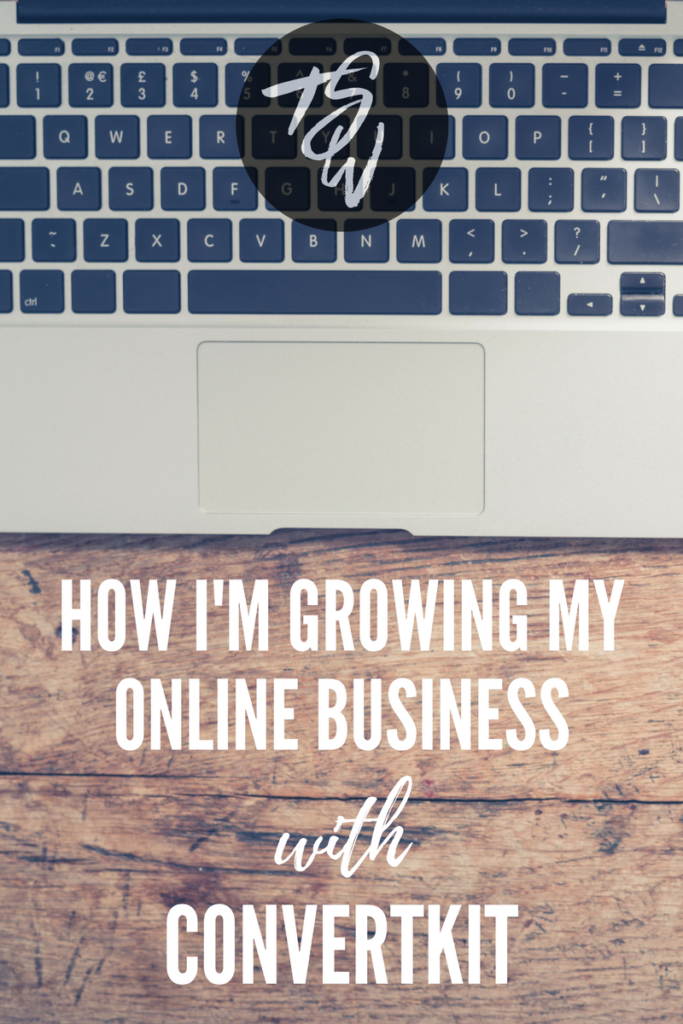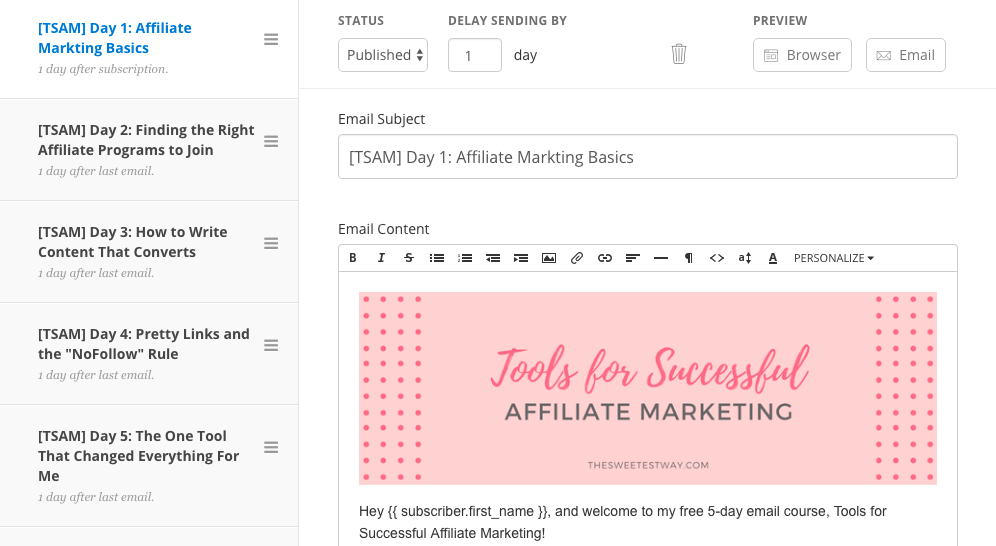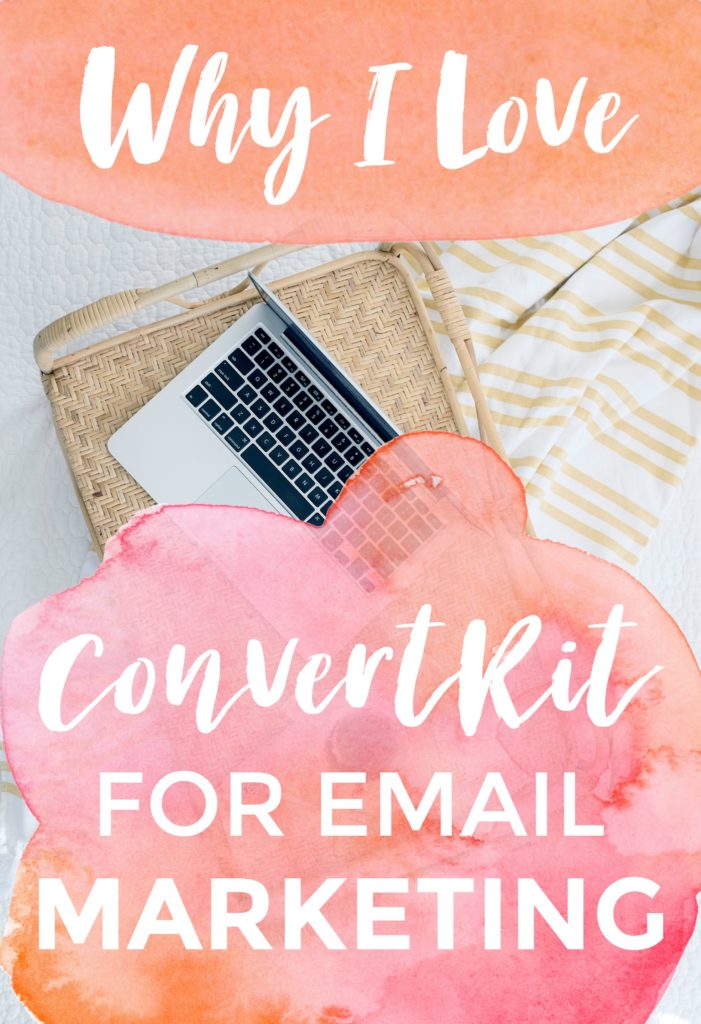This post contains affiliate links.
Let me kick this post off by stating a simple yet powerful truth: Switching from Mailchimp to ConvertKit was one of the best decisions I made for my business this year.
Boom!
Let me follow up by saying if you don’t know what Mailchimp or ConvertKit are, you cringe at the mere mention of the word “marketing,” or you do not have an online business to speak of, this post probably won’t be very useful to you.
Perhaps I can interest you in this story about that time I stayed with a complete stranger in Serbia?
For those of you who do have online businesses, hopefully you are already privy to the importance of email marketing in growing your brand. If not, no judgment–it took me a long time to truly understand it myself, but now that I’ve got a better grasp on it, it’s revolutionizing the way I do business.
“The money is in the list.” -Every Digital Marketer Ever
You’ve likely heard the online business maxim, “the money is in the list.” This saying, of course, refers to the idea that the best way to monetize an online business is by building a healthy email subscriber list. It’s a direct line to your target demographic, one that no website malfunction or infuriating social media algorithm can take away from you.
What remains slightly perplexing for many new entrepreneurs is figuring out exactly how to leverage that email list to start earning money from it. And that’s what I want to begin addressing today by explaining how I’m managing my email list with the help of ConvertKit, a powerful email marketing solution for professional bloggers.
Before I get down to explaining ConvertKit‘s awesome features, let’s talk about some of the hangups you might be having when it comes to email marketing.
If you’re ready to talk features, feel free to skip ahead and scroll down to the section titled “Why ConvertKit is Better Than MailChimp.”
If you’re a newly-minted marketer, the idea of selling to your email subscribers might give you the heebie-jeebies. I know I certainly felt that way in the beginning. They trusted me enough to give me privileged access to their inbox–did I really want to jeopardize that?
“It feels sleazy,” I hear you say. But if you’re attracting the right people to your email list in the first place, they should already be interested in what you’re selling or the kinds of things you’ll potentially sell in the future.
If you’re attracting the right tribe, you’re actually doing them a favor by introducing them to amazing products or goods that will be relevant and useful to their lives. You’re not just pushing anything and everything down their throats and hoping for the best–you’re sharing only the things you already know they’ll love.
Here’s an example of my opt-in form that gets right to the heart of what I do–help people live a life of their own creation instead of the boring 9-5 status quo. I’m attracting the dreamers, the doers, the think-outside-the-box-ers. Are you one of them?
“Okay, but I don’t have any products to sell,” I hear you lament. If you’re a blogger who’s just starting out and you have no products of your own to sell, building an email list from the beginning is still SO important. Because you aren’t building a list for the sole purpose of making sales. List building is relationship building.
It gives you a way to stay in close contact with people, get to know their needs and wants, their fears, hopes, and dreams. And then when you DO create your own products, you’ll know exactly what there’s a demand for. And who do you think your first customers will be? The people you spent time getting to know. The people you’ve provided value to FOR FREE through regular email communication. The people who dig your message and trust you to deliver.
But, you don’t even NEED your own products to sell. You can promote affiliate products to your email list just as easily; you can also offer services, or use your emails to drive traffic back to your website.
And when it comes to conversions (clicks, sales, you name it), email marketing leaves other avenues in the dust. I saw this firsthand when I launched my first digital product earlier this year.
In the months leading up to the release date, I was busily building my email list, gaining subscribers that had a strong interest in location independence and knew my ebook on the subject was coming out soon. I sold several copies BEFORE the launch to particularly eager subscribers, and more than 60% of my initial sales came from my email list, too. It. Was. Awesome.
“But I don’t have a big list. Shouldn’t I get more subscribers first?” Um, no! The size of your list matters little compared to what you do with it. And in many ways, a small list is actually more manageable. You can give personalized attention to the people who reply to you and really make them feel like a part of the fam. You can take the time to find what works and what doesn’t, before there are thousands of potential customers on the line.
For an example of how one entrepreneur leveraged a small list to earn $15,000 from a single launch, check out this episode of The Femtrepreneur Show and prepare to have your mind blown. In fact, just watch the whole thing–it’s loaded with useful info and the guest, Adrienne Dorison, is seriously inspirational.
“What do I even write to my subscribers? I don’t know where to begin!” Now, on this one, I feel you. I started out writing newsletter-style emails that had little to do with my website. They were “behind-the-scenes” updates on my current travels and although they were entertaining, they weren’t very useful.
These days, I simply focus on providing as much value as possible. When I learn something new, I share it. When I write new blog posts, I let people know. I tell my subscribers about special offers and sales on things I think they’ll enjoy.
But I’ll level with you–writing the right emails is still something I’m working on, so I am far from an expert. I’m learning from the best, though, and I’m willing to share! Pat Flynn of Smart Passive Income is a true guru, and he wrote a free guide to email marketing called Email the Smart Way. Download it here.
I also suggest subscribing to his and any other entrepreneurs’ email lists that you admire. This is a great way to see what the pros are doing while learning what you like and don’t like as a subscriber.
Of course, unsubscribes are a natural part of the list building process, and you shouldn’t let them discourage you. I used to feel personally offended whenever people unsubscribed from my list, but now, I welcome it. Many of my subscribers signed up before I rebranded, so chances are some of them simply weren’t interested in my new content.
If people aren’t picking up what I’m putting down, it usually means one of two things: either they weren’t the right subscribers for me, or there’s something I need to improve upon (I tend to assume it’s some combination of both). Was my subject line annoying? Was the email too long? Do they just hate my face?
There’s always room for improvement, but sometimes it’s just not the right fit, and that’s okay too.
Now with all that out of the way, let’s dive into ConvertKit!
Why ConvertKit is Better Than MailChimp
There are many similarities between ConvertKit and MailChimp, and on a basic level, they perform many of the same tasks. Capture subscribers. Use double or single opt-ins. Send emails. Send autoresponders. Send broadcasts (one-time emails).
But as your list (and your business) begins to grow, you’ll need a sophisticated (and simple) way to manage your subscribers, ensuring the exact right type of content goes to the right people. This is where MailChimp falls short.
With ConvertKit, tagging subscribers by interest is a breeze. Creating segmented lists is just as easy. To give you an example of how this is beneficial, let’s say I write a post about making money online and I want to send a broadcast to my peeps letting them know it’s live. However, many of my subscribers are travelers who are NOT interested in the digital nomad lifestyle or location independence. With list segmentation, I can avoid sending this broadcast to those people, thus avoiding a slew of angry unsubscribes from people who feel like I don’t “get them.”
If you wanted a subscriber on two different lists with MailChimp (people have many interests, you know!), you would pay for that subscriber TWICE. The more your list grows, the more costly this has the potential to be. This doesn’t happen with ConvertKit.
Another important way ConvertKit outshines MailChimp is with unlimited opt-in incentives. You could create a unique opt-in form for every single blog post if you wanted! That’d be insane, but the point is, you could. I’ll elaborate on this feature down below.
ConvertKit does come at a slightly higher price than MailChimp for the same number of subscribers, but the reason is simple–it does more.
The ConvertKit Tools I’m Using to Grow My Business
The following are the ConvertKit features I’ve found absolutely invaluable in growing my business through email marketing.
Subscriber Tags – Adding and subtracting tags from my subscribers allows me to know what they’re interested in. If someone joins my list from form embedded in a post about location independence–sweet!–I know they’re jonesin’ to build a lifestyle of freedom similar to mine and they get tagged accordingly. Someone else subscribes through a travel post? They get assigned a “general travel” tag, so I know not to bombard them with business tips and the like.
List Segmentation – Once my subscribers are tagged, they can then be grouped into segments. I might create a segment with my “general travel” and “location independence” subscribers together, in case I write something that will appeal broadly to both. Likewise, I would group my “make money online” tag with my “blogging as a business” tag to capture subscribers with similar interests of building online businesses.
Automated Sequences – I’ve only just begun to unlock the power of automated sequences, but so far I have three up and running. These are series of emails that are sent out at an interval specified by me, either to build trust and authority, to teach something valuable, or to lead them through a sales funnel that will hopefully end with a purchase. Most subscribers receive my “welcome sequence” where I introduce myself and my story in more detail, which is particularly useful to new readers.
Automation Rules – Automation rules allow me to do something with a subscriber based on an action they take. My welcome email asks people to click links based on their interests and then adds the appropriate tag. If a subscriber finishes an automated sequence, they can automatically be subscribed to a new one. I was even able to integrate my Gumroad account so that when people purchase my ebook, the tag “potential buyer” is removed and “customer” is added, which prevents me from further marketing my product to people who’ve already bought it.
Unlimited Opt-In Forms – I currently have 5 different opt-in forms on my site, each offering its own incentive. One form offers a free sample chapter of my ebook; another one is for a free 5-day email course on affiliate marketing. The possibilities here are limitless. ConvertKit will also host full landing pages for you, giving you yet another option for capturing leads. In my dashboard, each form displays its unique analytics, so I can keep a close eye on performance.
Simple Email Format – ConvertKit emails are designed simply. Plain, even. And that’s exactly the point. HTML-heavy emails (with lots of images and visuals) can have a lot of negative consequences for marketers. Did you know HTML-heavy emails: reduce open rates, reduce clickthroughs, and are generally preferred LESS than plain-text emails? Yup. Not only do many email providers filter HTML-rich emails (because they are assumed to be ‘commercial’), but people often prefer the informal feel of a text email that looks just like it came from a good friend.
To Sum Up, ConvertKit Kicks Ass
In case I haven’t already made it abundantly clear, I’m totally in love with ConvertKit. Their team has been inspiring and super helpful, and because the company is new and still relatively small, they’re excited to get feedback from users and eager to make improvements along the way.
And they’ve given me of one of my favorite entrepreneurial mantras, “create every day.” That t-shirt I’m wearing above? They sent it to me as a fun bonus for getting the hang of the platform’s various features. I’m even heading to a meetup they’re hosting soon in Seattle, I can’t wait to tell you how it goes!
If you’re searching for a powerful yet easy-to-use email marketing tool, I can’t recommend ConvertKit enough. Its ease of use, power, and simplicity put it in a league of its own!
Are you an email marketing mastermind? I’d love to hear how you’re using it to grow your online business, and if you’re not a ConvertKit user yet, what do you use instead?



